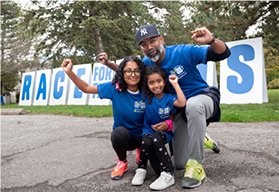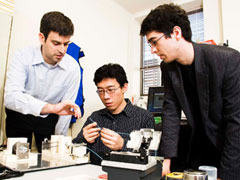By Design
By Laura Pratt
When Dr. Brian Courtney was a boy, he tried to build an airplane in his basement. He was in grade eight, and curious, and an ultralight in the cellar of his suburban home seemed just the thing. It was an early foray for this Sunnybrook Research Institute (SRI) scientist in the application of problem-solving powers to an irresistible challenge, one that would see him through to his present-day post, where the prospect of employing engineering concepts to improve shortcomings in medical technology has him flying higher than ever.
Courtney, who is also a fourth-year cardiology resident at the University of Toronto, heard his calling late. Twenty-five years old before he applied to medical school, Courtney had already acquired a computer engineering degree and invested a year in the workforce before Stanford University’s hospital affiliations opened his eyes.
“It’s not traditional to be in medicine with an engineering background,” he concedes, his big hands open in allowance. “But there are more and more people doing it.”
Today, the 34-year-old already has an impressive résumé of innovation. He hit his stride in 2001, when a pair of Stanford docs developed a pilot course in medical device design and proposed a project to come up with a solution for preventing distal embolization (when small blood vessels are blocked by downstream-flowing fragments or plaque during an angioplasty, a complication that can reduce heart function postoperatively. That doctors were aghast at his suggestion that they actually block the blood vessel in advance of the procedure (and then rinse it out and re-establish flow at the end) didn’t stop him from patenting the idea and coining a word—Rinspiration—en route.
Since then, products developed by Courtney and his team have achieved FDA approval, and he’s conducted a string of studies, revisited the design, started and sold a company, and launched another firm (this one to promote a catheter that detects the presence of dye in the coronary sinus and then drains it before the kidneys are exposed).
At SRI, Courtney is applying his engineering eye to the study of a kind of vascular lesion called chronic total occlusions, which refers to an artery that has been completely obstructed for more than 30 days. Ten years from now, he wants to be practising interventional cardiology while developing tools that will improve the medical profession.
“We have the ability to build medical devices from the ground up here,” he says. “And having our research team in close contact with clinicians and patients at Sunnybrook is very helpful, because we can identify problems that need to be solved and get early feedback.”
Courtney receives funding from the Canada Foundation for Innovation, the Canadian Institutes of Health Research and BioDiscovery Toronto.
PDF / View full media release »





